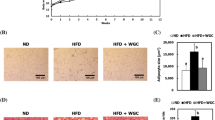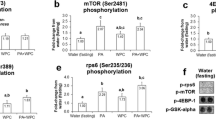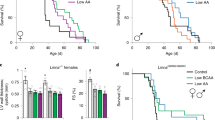Abstract
Purpose
Body weight in young growing and young adult animals was reduced by a high dietary density of whey protein concentrate; however, it is unclear whether dietary proteins similarly affect body weight in aging animals. Here, we examined whether whey protein or whey peptide ingestion suppressed body fat accumulation and affected protein expression and phosphorylation in skeletal muscle in aging mice.
Methods
Twenty-six male senescence-accelerated mouse prone 6 (SAMP6) mice were assigned randomly to three dietary treatment groups: 18.7 % casein control (CON), 18.7 % whey protein (WPR), and 18.7 % whey peptide (WPE). After 28 weeks of treatment, skeletal tissues were dissected and weighed for analysis. Western blotting was performed to examine the expression of AMP-activated protein kinase (AMPK), acetyl-CoA carboxylase (ACC), and adipose triglyceride lipase (ATGL) in quadriceps muscles.
Results
Body (CON: 47.6 ± 2.2 g, WPR: 48.2 ± 2.7 g, WPE: 38.3 ± 2.0 g) and relative white adipose tissue (CON: 38.5 ± 3.5 mg/g, WPR: 43.8 ± 4.0 mg/g, WPE: 21.1 ± 4.4 mg/g) weights were lower in the WPE group compared with the other two groups (p < 0.05), and no significant differences were observed between the CON and WPR groups. The relative weights of tibialis anterior muscle (CON: 1.04 ± 0.04 mg/g, WPR: 0.97 ± 0.03 mg/g, 1.23 ± 0.05 mg/g) and gastrocnemius muscle (CON: 3.02 ± 0.12 mg/g, WPR: 2.92 ± 0.15 mg/g, WPE: 3.65 ± 0.18 mg/g) were higher in the WPE group compared with the other groups (p < 0.05). The phosphorylation of AMPK (WPR: 1.03 ± 0.11, WPE: 1.36 ± 0.12; fold change from control) and ACC (WPR: 1.08 ± 0.07, WPE: 1.18 ± 0.05; fold change from control) in WPE was higher than in CON (p < 0.05). There were no significant differences in the expression levels of ATGL among the three groups.
Conclusions
These data suggest that a normal (or moderate excess) dietary density of whey peptide attenuates body fat accumulation via upregulation of fatty acid oxidation in skeletal muscle in aging mice.


Similar content being viewed by others
References
Ha E, Zemel MB (2003) Functional properties of whey, whey components, and essential amino acids: mechanisms underlying health benefits for active people (review). J Nutr Biochem 14:251–258
Belobrajdic DP, McIntosh GH, Owens JA (2003) Whey proteins protect more than red meat against azoxymethane induced ACF in Wistar rats. Cancer Lett 198:43–51
Belobrajdic DP, McIntosh GH, Owens JA (2004) A high-whey-protein diet reduces body weight gain and alters insulin sensitivity relative to red meat in Wistar rats. J Nutr 134:1454–1458
McIntosh GH, Regester GO, Le Leu RK, Royle PJ, Smithers GW (1995) Dairy proteins protect against dimethylhydrazine-induced intestinal cancers in rats. J Nutr 125:809–816
Candow DG, Chilibeck PD (2005) Differences in size, strength, and power of upper and lower body muscle groups in young and older men. J Gerontol A Biol Sci Med Sci 60:148–156
Short KR, Nair KS (2000) The effect of age on protein metabolism. Curr Opin Clin Nutr Metab Care 3:39–44
Short KR, Vittone JL, Bigelow ML, Proctor DN, Nair KS (2004) Age and aerobic exercise training effects on whole body and muscle protein metabolism. Am J Physiol Endocrinol Metab 286:E92–E101. doi:10.1152/ajpendo.00366.2003
Sakuma K, Yamaguchi A (2013) Sarcopenic obesity and endocrinal adaptation with age. Int J Endocrinol 2013:204164. doi:10.1155/2013/204164
Griffiths RD (1996) Muscle mass, survival, and the elderly ICU patient. Nutrition 12:456–458
Wolfe RR (2006) The underappreciated role of muscle in health and disease. Am J Clin Nutr 84:475–482
Hirofuji C, Ishihara A, Roy RR, Itoh K, Itoh M, Edgerton VR, Katsuta S (2000) SDH activity and cell size of tibialis anterior motoneurons and muscle fibers in SAMP6. NeuroReport 11:823–828
Takeda T, Hosokawa M, Higuchi K (1997) Senescence-accelerated mouse (SAM): a novel murine model of senescence. Exp Gerontol 32:105–109
Chen H, Yao XF, Emura S, Shoumura S (2006) Morphological changes of skeletal muscle, tendon and periosteum in the senescence-accelerated mouse (SAMP6): a murine model for senile osteoporosis. Tissue Cell 38:325–335. doi:10.1016/j.tice.2006.08.001
Niimi K, Takahashi E, Itakura C (2009) Adiposity-related biochemical phenotype in senescence-accelerated mouse prone 6 (SAMP6). Comp Med 59:431–436
Hardie DG, Ross FA, Hawley SA (2012) AMPK: a nutrient and energy sensor that maintains energy homeostasis. Nat Rev Mol Cell Biol 13:251–262. doi:10.1038/nrm3311
Reeves PG, Nielsen FH, Fahey GC Jr (1993) AIN-93 purified diets for laboratory rodents: final report of the American Institute of Nutrition ad hoc writing committee on the reformulation of the AIN-76A rodent diet. J Nutr 123:1939–1951
Rogers P, Webb GP (1980) Estimation of body fat in normal and obese mice. Br J Nutr 43:83–86
Kakigi R, Naito H, Ogura Y, Kobayashi H, Saga N, Ichinoseki-Sekine N, Yoshihara T, Katamoto S (2011) Heat stress enhances mTOR signaling after resistance exercise in human skeletal muscle. J Physiol Sci 61:131–140. doi:10.1007/s12576-010-0130-y
Sugiura T, Murakami N (1990) Separation of myosin heavy chain isoforms in rat skeletal muscles by gradient sodium dodecyl sulfate-polyacrylamide gel electrophoresis. Biomed Res 11:87–91
Pennings B, Boirie Y, Senden JM, Gijsen AP, Kuipers H, van Loon LJ (2011) Whey protein stimulates postprandial muscle protein accretion more effectively than do casein and casein hydrolysate in older men. Am J Clin Nutr 93:997–1005. doi:10.3945/ajcn.110.008102
Morifuji M, Sakai K, Sanbongi C, Sugiura K (2005) Dietary whey protein downregulates fatty acid synthesis in the liver, but upregulates it in skeletal muscle of exercise-trained rats. Nutrition 21:1052–1058. doi:10.1016/j.nut.2005.01.010
Moughan PJ, Cranwell PD, Smith WC (1991) An evaluation with piglets of bovine milk, hydrolyzed bovine milk, and isolated soybean proteins included in infant milk formulas. II. Stomach-emptying rate and the postprandial change in gastric pH and milk-clotting enzyme activity. J Pediatr Gastroenterol Nutr 12:253–259
Weigle DS, Breen PA, Matthys CC, Callahan HS, Meeuws KE, Burden VR, Purnell JQ (2005) A high-protein diet induces sustained reductions in appetite, ad libitum caloric intake, and body weight despite compensatory changes in diurnal plasma leptin and ghrelin concentrations. Am J Clin Nutr 82:41–48
Dangin M, Boirie Y, Guillet C, Beaufrere B (2002) Influence of the protein digestion rate on protein turnover in young and elderly subjects. J Nutr 132:3228S–3233S
Boirie Y, Dangin M, Gachon P, Vasson MP, Maubois JL, Beaufrere B (1997) Slow and fast dietary proteins differently modulate postprandial protein accretion. Proc Natl Acad Sci USA 94:14930–14935
Calbet JA, Holst JJ (2004) Gastric emptying, gastric secretion and enterogastrone response after administration of milk proteins or their peptide hydrolysates in humans. Eur J Nutr 43:127–139. doi:10.1007/s00394-004-0448-4
Lopaschuk GD, Ussher JR, Folmes CD, Jaswal JS, Stanley WC (2010) Myocardial fatty acid metabolism in health and disease. Physiol Rev 90:207–258. doi:10.1152/physrev.00015.2009
Park H, Kaushik VK, Constant S, Prentki M, Przybytkowski E, Ruderman NB, Saha AK (2002) Coordinate regulation of malonyl-CoA decarboxylase, sn-glycerol-3-phosphate acyltransferase, and acetyl-CoA carboxylase by AMP-activated protein kinase in rat tissues in response to exercise. J Biol Chem 277:32571–32577. doi:10.1074/jbc.M201692200
Ruderman NB, Park H, Kaushik VK, Dean D, Constant S, Prentki M, Saha AK (2003) AMPK as a metabolic switch in rat muscle, liver and adipose tissue after exercise. Acta Physiol Scand 178:435–442
Abu-Elheiga L, Matzuk MM, Abo-Hashema KA, Wakil SJ (2001) Continuous fatty acid oxidation and reduced fat storage in mice lacking acetyl-CoA carboxylase 2. Science 291:2613–2616. doi:10.1126/science.1056843
Zimmermann R, Strauss JG, Haemmerle G, Schoiswohl G, Birner-Gruenberger R, Riederer M, Lass A, Neuberger G, Eisenhaber F, Hermetter A, Zechner R (2004) Fat mobilization in adipose tissue is promoted by adipose triglyceride lipase. Science 306:1383–1386. doi:10.1126/science.1100747
Smirnova E, Goldberg EB, Makarova KS, Lin L, Brown WJ, Jackson CL (2006) ATGL has a key role in lipid droplet/adiposome degradation in mammalian cells. EMBO Rep 7:106–113. doi:10.1038/sj.embor.7400559
Conflict of interest
The authors have read the journal’s policy and declare the following conflicts: SM is an employee of Megmilk Snow Brand Co., Ltd, Japan and HN received a research fund from Megmilk Snow Brand Co., Ltd. The sponsor had no control over the study design, decision to publish, or preparation of the manuscript. There are no patents, products in development, or marketed products to declare.
Author information
Authors and Affiliations
Corresponding author
Electronic supplementary material
Below is the link to the electronic supplementary material.
394_2014_736_MOESM1_ESM.tif
Representative gel of the four isoforms (I, IIa, IIx and IIb) of skeletal muscle myosin heavy chain (MHC) in the control (CON), whey protein (WPR), and whey peptide (WPE) dietary groups. (TIFF 942 kb)
Rights and permissions
About this article
Cite this article
Ichinoseki-Sekine, N., Kakigi, R., Miura, S. et al. Whey peptide ingestion suppresses body fat accumulation in senescence-accelerated mouse prone 6 (SAMP6). Eur J Nutr 54, 551–556 (2015). https://doi.org/10.1007/s00394-014-0736-6
Received:
Accepted:
Published:
Issue Date:
DOI: https://doi.org/10.1007/s00394-014-0736-6




